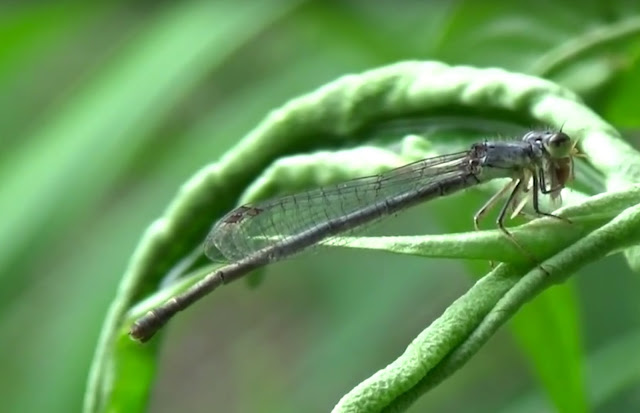 |
| Fragile Forktail female- Linda Bower |
 |
| Dragonfly naiad - REK |
Linda Bower of our Master Naturalists sent me the following study and videos of her Fragile Forktail Damselfly, Ischnura posita.
If you spend any time at a local pond, you may miss the well-named Fragile Forktail Damselfly (FFD). It is almost the size of a straight pin, at less than an inch long. I found it with binoculars and the zoom on my camcorder and then became obsessed with filming it’s various activities. Admittedly, my camcorder faced it’s limitations with the FFD’s size, distance, and preference to stay in the shade.
 |
| FF male - Patrick Murray |
 |
| Eastern Forktail - Fyn Kynd |
I have hours and hours of video showing the Fragile Forktail laying eggs and I’m still not satisfied with the footage. Apparently they don’t like to lay eggs near the shore. Still, it is fascinating to watch this video, which shows her size relative to a tiny Juniper berry.
Happily, I found a female eating lunch right next to where I was sitting. Any parent would be proud of how well she cleaned her face and hands after eating in this video.
My obsession will certainly continue through the summer. Stay tuned to my YouTube channel for more views of dragonflies and damselflies!
The process is explained by Naturally Curious with Mary Holland:
"At the end of its larval stage, a dragonfly larva crawls out of the water where it’s been living and climbs up onto emergent vegetation, or a nearby rock, where it clings as its skin splits along its back and head. The adult winged dragonfly pulls itself out of its larval skin through this hole, and grasps the skin (or vegetation or rock) while it pumps its body full of air and sends fluid into its wing veins. This fluid causes the wings to enlarge — the wing expansion that is evident in these two photographs took place in less than ten minutes. When it first emerges from its skin, a dragonfly is pale and soft, and the wings have a characteristic pearlescent sheen, as in these photographs. Within a day or so the wings lose this sheen, the body hardens and colors start to develop."

